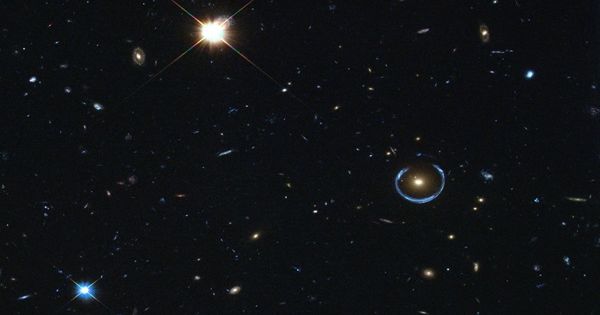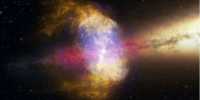Astronomers found a new way to see the dark matter in a new light
A small team of astronomers from the Swinburne University of Technology has found a new way to ‘see’ the elusive dark matter halos that surround galaxies. The work is published in Monthly Notices of the Royal Astronomical Society.
Our Universe is filled with many billions of galaxies. Scientists currently estimate that up to 85% of the mass in the universe is effectively invisible. To our eyes – and in optical telescopes – these galaxies appear as collections of millions or even trillions of stars. This ‘dark matter’ cannot be observed directly, because it does not interact with light in the same way as the ordinary matter that makes up stars, planets, and life on Earth. However, this is just the tip of the iceberg.
So how do we measure what cannot be seen? The key is to measure the effect of gravity that the dark matter produces. One of the big puzzles of cosmology is that our telescopes only see a small fraction of the total mass that exists in the Universe.
The new research focuses on an effect called weak gravitational lensing, which is a feature of Einstein’s general theory of relativity. “The dark matter will very slightly distort the image of anything behind it,” says Associate Professor Edward Taylor, who was also involved in the research. “The effect is a bit like reading a newspaper through the base of a wine glass.”
Pol Gurri, a Ph.D. student at the Swinburne University of Technology who led the latest study, explains: “It’s like looking at a flag to try to know how much wind there is. You cannot see the wind, but the flag’s motion tells you how strongly the wind is blowing.”
Weak gravitational lensing is now one of the most powerful ways of mapping the Universe’s dark matter material. Today, in Australia, the Swinburne team has used the ANU 2.3m Telescope to map how gravitationally lensed galaxies rotate. “Because we know how stars and gas are supposed to move inside galaxies, we know roughly what that galaxy should look like,” Because we know how stars and gas are supposed to move inside galaxies, we know roughly what that galaxy should look like,” says Gurri.
New research reveals how this velocity information allows a much more reliable calculation of the lens effect that can be achieved by using shape alone. “With our new way of seeing the dark matter,” Gurri says, “we hope to get a clearer picture of where the dark matter is and what role it plays in how galaxies form.”
Future space missions, such as NASA’s Nancy Grace Roman Space Telescope and the Euclid Space Telescope of the European Space Agency, are partially planned to allow observations of this type dependent on the shapes of hundreds of millions of galaxies. “We have shown that we can make a real contribution to these global efforts with a relatively small telescope built in the 1980s, just by thinking about the problem in a different way,” adds Taylor.















